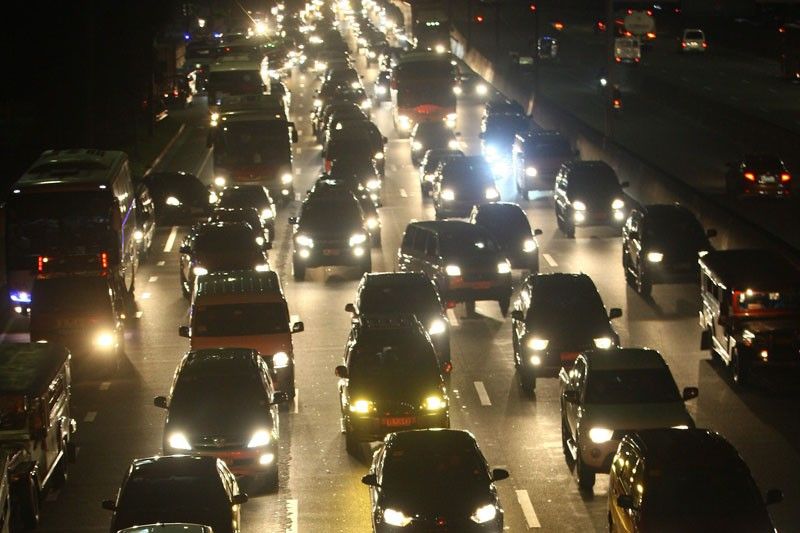Metro Manila traffic now costs P3.5 billion daily

Citing preliminary figures from the Updated Metro Manila Transport Roadmap, JICA Chief Representative to the Philippines Susumu Ito said economic loss attributed to traffic congestion as of 2017 has risen dramatically from the estimate of P2.4 billion in 2014 when the roadmap was created with the assistance of the National Economic and Development Authority (NEDA).
MANILA, Philippines — The worsening traffic situation in Metro Manila is now costing the country P3.5 billion in missed economic opportunities daily, hence the need for more projects that will ease congestion and improve connectivity in and out of the metropolis, the Japan International Cooperation Agency (JICA) said yesterday.
Citing preliminary figures from the Updated Metro Manila Transport Roadmap, JICA Chief Representative to the Philippines Susumu Ito said economic loss attributed to traffic congestion as of 2017 has risen dramatically from the estimate of P2.4 billion in 2014 when the roadmap was created with the assistance of the National Economic and Development Authority (NEDA).
This was attributed to the rapid expansion of Metro Manila proper, which covers 17 cities, and the Mega Manila area, which includes the adjacent provinces of Bulacan, Rizal, Laguna and Cavite. The report is expected to be finalized in April.
In a presentation made during the 36th Annual Joint Meeting of the Philippines-Japan Economic Coordinating Committee and the Japan-Philippines Economic Coordinating Committee yesterday, Ito said Mega Manila is expected to become one of the largest mega cities in the world by 2035 as new growth centers emerge and population growth in outer areas is expected to outpace that of Metro Manila proper.
Mega Manila’s population is placed at around 24 million in 2015 but is expected to balloon to 38 million in 2035, putting strain on an already decrepit infrastructure backbone.
“So Mega Manila will be larger. It will be one of the largest cities in the world. Metro Manila will be more congested while BLRC (Bulacan, Laguna, Rizal, Cavite) will see rapid growth,” said Ito.
Without new transportation infrastructure, daily economic losses due to traffic congestion can rise to P5.4 billion daily by 2035, he said.
With the implementation of the government’s ambitious Build, Build, Build (BBB) program, losses can be cut to P3 billion daily and with the implementation of additional projects, can be further trimmed down to P2.4 billion due to missed economic opportunities.
For this reason, Ito said the Japanese government “fully supports” the government’s aggressive infrastructure development program.
“So the conclusion that we have is that BBB is a right direction. But even with BBB, bottlenecks will still remain in the outer areas so therefore, additional projects should be implemented,” said Ito.
The administration’s aggressive infrastructure development program entails the rollout of 4,985 infrastructure projects, out of which 75 are flagship, big-ticket transport-related projects that aim to improve connectivity in Metro Manila and in the provinces.
All in all, the projects listed in the government’s investment program for 2017-2022 entail expenditure of over P9 trillion, which would be financed through a mixture of foreign loans, grants and government appropriations.
JICA’s transport roadmap for the Philippines contains proposals for the rollout of more railways, expressways and modern traffic management systems.
The updating of the roadmap is meant to “grasp the situation change in the transport sector policy” in line with the BBB program, said Ito. It will also pave the way for the revision of transport development strategies in the country and to re-estimate economic losses due to worsening traffic.
Several of the flagship projects in the BBB program are included in the JICA transport roadmap.
Those that are now progressing include the North-South Commuter Railway Malolos-Tutuban Line, which is seen to undergo procurement in the first half of 2018; the North-South Commuter Railway Malolos-Clark, Tutuban-Los Baños Line for which detailed engineering design and preparation of bid documents are ongoing.
The loan agreement signing for the first phase of the Metro Manila Subway Project, which connects the northern and southern part of Metro Manila, is expected to commence as scheduled in March.
Socioeconomic Planning Secretary Ernesto Pernia said yesterday the government is pushing for an earlier groundbreaking schedule for the project in the third quarter of 2018 instead of the first quarter of 2019. This, he said, was discussed during the recently held Japan-Philippines Joint Committee on Infrastructure Development and Economic Cooperation meeting in Cebu.
The government, he said, is even planning to attract overseas Filipino workers in the Middle East to come home and participate in the BBB program as more big-ticket infra projects, such as the country’s first subway system, are set to be rolled out soon.
Ito, however, said the possibility of an earlier groundbreaking for the project is still being discussed.
The subway is slated for completion by 2025 but Pernia said the government wants it to be “partially operable” by the end of the Duterte administration in 2022. This entails having at least three to four stations out of the total of 13 stations working.
- Latest
- Trending





























